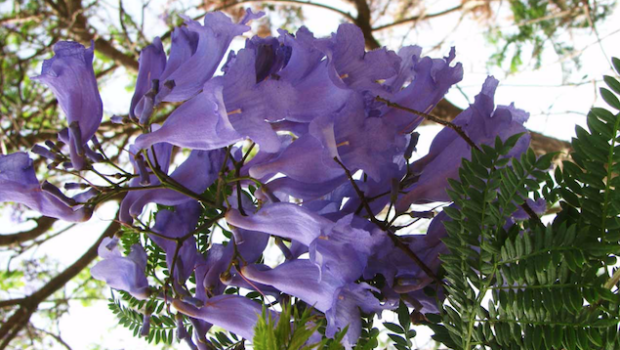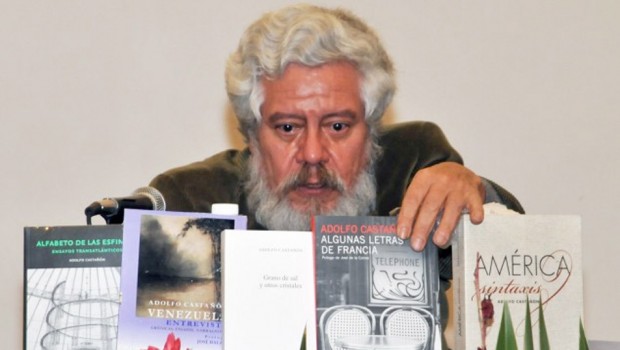THE JACARANDAS WHISPER
Dicen las jacarandas
Alberto Ruy-Sánchez
(México: Ediciones Era, 2019)
Translated from the Spanish by Rhonda Dahl Buchanan
(Buffalo, New York: White Pine Press, forthcoming 2025)
In his volume of poetry, Dicen las jacarandas (México: Ediciones Era, 2019), the Mexican writer Alberto Ruy-Sánchez pays homage to the amazing jacaranda trees that transform Mexico City into a purple spectacle heralding the arrival of spring. Mexico City’s annual flower contemplation ritual, known in Japan as the “Hanami,” has its origins in 1930, when President Ortiz Rubio wanted the streets of the capital to be lined with cherry trees, like those in Washington, D.C. Tatsugoro Matsumoto, a Japanese gardener and landscape architect who had emigrated to Mexico City, was commissioned to oversee the botanical campaign, and recommended jacarandas because Mexican winters were too mild for cherry trees to blossom. Nearly a century later, Alberto Ruy-Sánchez reflects upon the paradoxical nature of the jacaranda trees: their immortal and transient character, the myths of their origins and name, their multicultural history of migration, and the lessons they offer about the human condition. His lyrical poems invite the reader to contemplate the jacaranda tree as a living being and listen to what she has to say. It was a challenge to capture in English the melodic and rhythmic essence of the original poems, and to translate the internal word play and alliteration in the verses. I am grateful to the author for his insightful suggestions and for encouraging me to regard each poem as a song, “as if the trees were singing to the wind.” Although jacaranda season is ephemeral, the purple flowers blossom anew in the verses of this book, allowing the contemplation ritual to extend indefinitely.
— Rhonda Dahl Buchanan
Estas palabras
Cada ramo en la rama amoratada
es el ritmo alterado de su savia.
Delirio de sus venas que florece,
hervor de tierra dócil, embriagada.
No parecen pétalos, son palabras,
racimos de sílabas que palpitan.
Cuentan mil historias que el aire entiende:
amores y desamores, lamentos.
Cantan los goces que se multiplican,
los placeres fugaces y secretos.
Son animales, sabores, anhelos,
humo, premoniciones, amenazas.
Su raíz aérea se hunde en mis sueños,
y el viento que las despeina es mi aliento.
No sólo flores, también son palabras
de la lengua sutil que nos inventa.
These Words
Each bunch on the branch bruised purple
rises from the frenzied rhythm of her sap.
Wild dreams blossoming from her veins,
from the intoxicating zeal of docile soil.
Her pretentious petals are words,
panicles of pulsating syllables.
They tell a thousand stories to the wind,
of loves, losses, and sorrows.
Songs of mounting pleasures,
of secret and fleeting delights.
They are savory creatures, yearnings,
smoke, premonitions, and omens.
Her aerial roots settle in my dreams,
entangled by the wind that is my breath.
Not mere flowers, they are also words
of the subtle language that conceives us.
Inmortales y fugaces
Apariciones
multiplicadas,
fantasmas
hambrientos.
Se precipitan
al piso
y al mismo tiempo
renacen
en la rama.
Como si vivieran
más allá de la vida.
Fantasmas amoratados:
su obstinación
entusiasma, posee,
es más que gozo:
fascinante brujería.
Immortal and Fleeting
Proliferating
apparitions,
ravenous
phantoms.
They swirl
to the ground
and swiftly reappear
on the branch,
a startling rebirth
in the afterlife.
Ghosts bruised blue,
their tenacity
excites and possesses.
More than joy:
fascinating sorcery.
Mitología japonesa
Un jardinero de oriente,
de la isla de los asombros,
se propuso en las aceras
de esta ciudad de palacios,
crear un jardín callejero:
una invasión de mil flores
que se caen y resucitan.
Lo que vive en sus jardines
es otra noción del cielo.
Sí, el paraiso se siembra
y el edén se manicura.
Trajo del sur la semilla
y la aclimató a su sueño:
árboles que escupen flores
que en el aire se adelgazan.
Se inventó una especie rara
de árbol alto y muy sediento
que si se arraiga obsesivo
abraza al viento gozoso
y a los ojos nos regala
cada marzo un terremoto
de flores que en filigrana
se meten entre nosotros,
sacuden certezas vanas
con su belleza ligera:
dan al sorprendido instante
el logro de ser eterno.
Japanese Mythology
A gardener from the East,
from the island of wonders,
set out to create
an urban garden
along the sidewalks
of this city of palaces:
a foray of a thousand flowers
falling and rising again.
What thrives in his gardens
is another vision of heaven.
Indeed, paradise is sown
and Eden manicured.
He brought the seed from the south,
conforming it to his dream:
trees hurling flowers,
a diaphanous whirl in the air.
A rare species was conceived,
a tall tree with a mighty thirst.
If her zealous roots take hold,
she blissfully embraces the wind
and treats the eye
every March to a seismic tremor
of filigreed flowers.
They mingle among us
uprooting vain certainties
with their feathered beauty
and granting the awestruck moment
a gift of eternal life.
Su silencio es palabra
Y en la noche de la calle
donde perfilan su sombra
siguen cayendo del árbol
las palabras demoradas.
Hasta el viento es más obscuro
cuando la luna está ausente
y en los ojos del silencio
la jacaranda perdura.
Nada detiene la ausencia
que se teje en su presencia,
ni el esplendor escondido
latiendo en su faz discreta.
En su racimo barroco
o en su abandono volátil,
en su seductor tapete
o en su semilla sonora,
en la sed de su raigambre
o en lo verde de la rama
crece perenne, invisible,
atemporal y caduca.
Nada banal hay en ella,
todo trasciende su fuga.
Dice cosas cuando calla,
y dice más si la escuchas.
Her Silence is a Word
On the street, as night
traces their shadows,
lingering words
keep falling from the tree.
Even the wind is more obscure
under the absent moon
and in the watchful eyes of silence
the jacaranda endures.
Nothing restrains the absence
entwined in her presence,
nor the hidden splendor
pulsing in her humble guise.
In her baroque bouquet
or rampant abandon,
in her seductive carpet
or sonorous seed,
in her thirsty roots,
or boughs of green,
she grows perennial, invisible,
timeless and ephemeral.
Nothing about her is trivial.
She transcends her season’s end.
She whispers when silent,
even more if you listen to her.
*Cover Image, courtesy of the author
 Alberto Ruy-Sánchez is an award-winning writer and editor who has authored thirty-three books of fiction, non-fiction, and poetry. His works have been translated into fifteen languages. Since 1988, he has served as the co-editor of the independent cultural project Artes de México. He is the recipient of Mexico’s National Award for Arts and Literature and has won National and International Awards for Editorial Merit, among many other international prizes and distinctions. For more information, visit: www.albertoruysanchez.com
Alberto Ruy-Sánchez is an award-winning writer and editor who has authored thirty-three books of fiction, non-fiction, and poetry. His works have been translated into fifteen languages. Since 1988, he has served as the co-editor of the independent cultural project Artes de México. He is the recipient of Mexico’s National Award for Arts and Literature and has won National and International Awards for Editorial Merit, among many other international prizes and distinctions. For more information, visit: www.albertoruysanchez.com
 Rhonda Dahl Buchanan, Professor Emerita of Spanish at the University of Louisville, has translated works by authors from Latin America and Spain. She received an NEA Literature Fellowship for the translation of Alberto Ruy Sánchez’s novel Los jardines secretos de Mogador. White Pine Press published The Secret Gardens of Mogador and Poetics of Wonder: Passage to Mogador and will publish Dicen las jacarandas/ The Jacarandas Whisper in a bilingual edition in fall 2025. For more information, visit: www.rhondadahlbuchanan.com.
Rhonda Dahl Buchanan, Professor Emerita of Spanish at the University of Louisville, has translated works by authors from Latin America and Spain. She received an NEA Literature Fellowship for the translation of Alberto Ruy Sánchez’s novel Los jardines secretos de Mogador. White Pine Press published The Secret Gardens of Mogador and Poetics of Wonder: Passage to Mogador and will publish Dicen las jacarandas/ The Jacarandas Whisper in a bilingual edition in fall 2025. For more information, visit: www.rhondadahlbuchanan.com.
©Literal Publishing. Queda prohibida la reproducción total o parcial de esta publicación. Toda forma de utilización no autorizada será perseguida con lo establecido en la ley federal del derecho de autor.
Las opiniones expresadas por nuestros colaboradores y columnistas son responsabilidad de sus autores y no reflejan necesariamente los puntos de vista de esta revista ni de sus editores, aunque sí refrendamos y respaldamos su derecho a expresarlas en toda su pluralidad. / Our contributors and columnists are solely responsible for the opinions expressed here, which do not necessarily reflect the point of view of this magazine or its editors. However, we do reaffirm and support their right to voice said opinions with full plurality.
Posted: March 5, 2025 at 10:19 pm










